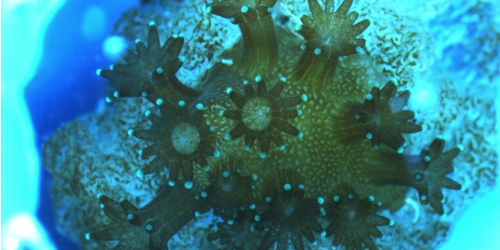Coral Polyps Dance ’n Sync
Images of vibrant, rainbow-colored coral reefs bleached white repeatedly capture headlines as a warning about the impacts of warming on the environment. Conserving reefs is a complex problem that will require improved understanding of the biological and physical functions of corals and of the individual organisms that comprise them. These organisms, known as coral polyps, can contract, extend, and wave—movements that scientists think could play a role in how corals feed, grow, and reproduce. Now Shuaifeng Li from the University of Washington, Seattle, and colleagues have mathematically modeled the movements of coral polyps, revealing that the random motions of the polyps are correlated [1].
For their experiments, Li and colleagues placed a coral nubbin, a coral fragment made up of several polyps, in an octagonal, water-filled tank. Each side of the tank contained a valve, and the team used these valves to control the flow of water around the nubbin. They then measured the movements of the nubbin’s polyps under various light and temperature conditions.
The team found that—under tested environments—the random motions of individual polyps were correlated: when one polyp waved on a nubbin, all the polyps similarly waved. However, temperature and light affected the degree to which the polyps’ movements were linked. They found that under blue light and hot water the polyps swayed less in sync than under red light and cold water. The change in correlated movements was more pronounced with light change than with temperature change.
Li and his colleagues say that they don’t yet know the biological function of the correlated random motion that they observed, but they plan to investigate that in future experiments.
–Allison Gasparini
Allison Gasparini is a freelance science writer based in Santa Cruz, CA.
References
- S. Li et al., “Spatiotemporal dynamics of coral polyps on a fluidic platform,” Phys. Rev. Applied 18, 024078 (2022).




